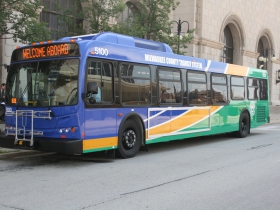The Disconnected City
New study shows no way for workers to get to jobs. What are its solutions?
A new study by the ever-busy Public Policy Forum finds the Milwaukee metropolitan area is badly disconnected, with no way for many workers to get to jobs in outlying counties. The study “confirms the long-held notion that public transportation services are limited or non-existent in many suburban job centers” in the four-county metro area, its authors state.
The study offers suggestions on both long-term and short-term solutions to a problem it admits is not easily solved.
Here is the problem in a nutshell: The report finds there are 29 “job centers” in the four county area, locations where there are at least 10,000 jobs. More than a third — 11 job centers which employ more than 204,000 people — are outside Milwaukee County and relatively inaccessible for workers from this county.
Why can’t workers get there?
-Among city of Milwaukee residents, 13 percent of workers do not have access to a personal automobile, compared with 6 percent of workers in Milwaukee County’s suburbs and 4 percent or less in Waukesha, Ozaukee, and Washington counties, the study notes.
-Cuts in service by the Milwaukee County Transit System have resulted in a 22 percent decline in total annual bus miles between 2000 and 2012, causing “tens of thousands of jobs to become inaccessible via public transportation.”
-Attempts by cooperation between Milwaukee County and Waukesha county bus systems, and between government and private employers, are complicated and difficult to achieve and have had little success.
“Overall, among the Milwaukee metro area’s 29 job centers, 15 have relatively high levels of public transit access, including those located primarily within the cities of Milwaukee, Wauwatosa, and West Allis. By contrast, four job centers are completely inaccessible by transit (Germantown, Oconomowoc, New Berlin, and West Bend). The 10 remaining job centers are connected by transit on a limited basis, including those located in Brookfield, Franklin, Menomonee Falls, Mequon, Oak Creek, Pewaukee, Waukesha, and Milwaukee County’s North Shore communities.”
Of the four counties in the metro area, “Washington County is the least accessible by transit,” the report notes.
Connecting workers to jobs in such areas is not easy because:
-“Many suburban industrial parks… are isolated from other land uses that generate transit riders and thus are unable to meet typical measures of transit service productivity.”
-“Funding for trial routes is available through special federal programs, but those routes are difficult to sustain after initial funding runs out.”
-“Express routes cannot produce… significant time savings… within the confines of existing service requirements, existing technologies, and variable work hours/shifts” of employers.
The report nonetheless looks at the potential to extend or improve Milwaukee county bus routes to adjoining suburbs, while noting that any such plan must take into account the bus system’s typical gauge — the productivity of “passengers per bus route” — which is calculated by dividing the total number of passengers on a given route by the aggregate number of hours buses are in operation on that route. The general standard used by Milwaukee’s system is that “a bus route must produce at least 22 PBH to be considered productive enough to be maintained.”
Route extensions to suburban job hubs, rather than new routes are most likely to meet this standard, the report finds. For instance, restructuring the bus service to better connect workers to jobs in Oak Creek, would cost an additional $1.2 million annually, or $540,000 annually for a more service efficient model. Better service on an express route from UW-Milwaukee to Downtown to Brookfield Square would cost $1.2 million extra per year. But given the cuts in federal grants that have occurred, the only potential funding source would be the Milwaukee County property tax, the report notes.
The complications involved in private/public transit partnerships are illustrated by Milwaukee’s Route 6 bus line, which connected Milwaukee with West Allis and New Berlin, serving the Quad/Graphics plant in West Allis and the New Berlin Industrial Park. “Funding for the route was provided by Quad/Graphics, Waukesha County, and Milwaukee County. In 2004, both Quad/Graphics and Waukesha County decided to discontinue funding for the route because of declining ridership. At that point, Milwaukee County no longer could justify funding the route on its own, so the route was eliminated.”
Other solutions developed during the past two decades have included commuter van pools, shuttle services, and car-purchasing programs, which “can transport workers to suburban job locations in a manner that is more flexible and individualized than fixed-route bus service. To date, however, these services have operated on a relatively small scale and have had mixed results,” the study notes.
All of which brings us back to the central problem, that suburban and particularly ex-urban development has been structured in a way that makes homes unaffordable for potential workers, doesn’t offer them much in the way of apartments or rental units, and locates businesses in areas that are not easily connected via fixed bus routes. “From a workforce and economic development perspective, therefore, it should be an imperative for governments to encourage businesses with workforce challenges to locate in or near higher-density areas where public transit services already exist or where new transit connections could be sustained,” the study concludes.
Brave words, but are they likely to have much impact? We’ll see.
Short Take
This study was tightly controlled and released a day ahead of time to the Milwaukee Journal Sentinel. I suspect this was done because the Public Policy Forum’s last report, on the financial needs of cultural and recreational groups, was leaked to me ahead of time. As I noted then, the study was only going to be shared with the Journal Sentinel and the Business Journal, and some may have felt those publications would not take as critical a look at the issue of funding for a new NBA arena.
So this time the PPF made sure only the Journal Sentinel got the report a day ahead of anyone in the media. PPF President Rob Henken says there is nothing new about this and that his organization has done so at times when there is a media specialist they want to give first access. “In this case, the JS has always had a reporter who specializes in transportation, so we offered it to her.”
Whatever the reason for this decision, I don’t think the strategy worked so well. The newspaper did a brief, ten paragraph story on the study that all but shouts out the message: this report is not very important.
At some point the powers that be will decide to treat all the media in town equally and give equal access on new studies and breaking news. After all, these are subjects that concern all of us in the community. But until such time, we’re confident Urban Milwaukee will find a way to report on these issues.
Murphy's Law
-
National Media Discovers Mayor Johnson
 Jul 16th, 2024 by Bruce Murphy
Jul 16th, 2024 by Bruce Murphy
-
Milwaukee Arts Groups in Big Trouble
 Jul 10th, 2024 by Bruce Murphy
Jul 10th, 2024 by Bruce Murphy
-
The Plague of Rising Health Care Costs
 Jul 8th, 2024 by Bruce Murphy
Jul 8th, 2024 by Bruce Murphy






















How much have they explored doing non-traditional bus routes that focus more on times when there are shift changes and the like where ridership would be highest? You can even try to work with businesses in concentrated areas to coordinate their work schedules to help accommodate the design. I’m sure the public/private partnership in this would be difficult… and if the measure of success is a profitable bus line then I doubt it would work. However, if we see transit to the job centers outside of Milwaukee as an investment in the region, I think there’s a real benefit for the businesses, the communities they are in, and the workers looking for jobs.
Don’t worry too much about the media issue. How many people first turn to Journal Sentinel for their news?? It has got to be a dwindling number.
I’ve been providing dislocated worker and other job seeker services since 1995. Transportation access to jobs has been and remains a key issue. while this is a new study, it is not by any means the first and nothing ever seems to improve. Action committees meet, summits are summited and the problem continues. These “job centers” where thousands of jobs are located are made up by and large of smaller enterprises none of whom have a critical number of openings. If there are 20 people who can’t get to work, there are 20 other unemployed waiting to give it a try. When I worked in manufacturing in the 70s and 80s the “job centers” were large corporations each employing thousands and jobs openings were plentiful, and the companies had clout. At Briggs when the production schedule changed, the bus schedule changed. You can look it up.
Is it poetic justice or just sweet irony that the sponsor of one of the car-purchasing programs is Walmart? How many Walmart employees do you think qualify for or can take advantage the program?
Add to the job sprawl another disadvantage: that clients and vendors will not enjoy coming to your offices when it is in an office park surrounded by parking. Trust me: I had to visit a company a potential vendor in New Berlin and it sucked being there. Never went back. and was delighted when that company didn’t win much business from my company.
Earth to corporate decision-makers: your business will do much better if it is in a fun downtown. New York, Cleveland, Milwaukee — as long as it is a walkable place with restaurants, bars, cafes, and streetlife — it is good.
Anecdote time: I live in ZIP code #13 (53212) and work in ZIP code #26 (53092).
For those going Mequon to Milwaukee, you can take the Ozaukee County Express, route 143 in the morning, a fine joint project between the two county governments that I almost always see full of riders during peak times.
But for those going my direction, the 143 timetables make it near-impossible to use it for commutes for daytime jobs. The only alternative is 42U, the U-bus designed to provide service to MATC North and Concordia. The service is infrequent (hourly if not less) and only runs during the school year. In short, it’s near impossible to depend on for commuting purposes.
Car ownership is a must, and isn’t a financial hardship for me personally, but there are probably quite a few service-type jobs up there that could instantly become viable for a rather high-unemployment area of the city just by running a few more buses going the opposite direction every day.
In all, this Walker academic career piece seems balanced, but overdone, both here and in MJS.
The big issue for this reader is when we’ll get a look at Murphy’s 4th grade report card–specifically arithmetic grades. This, in light of the wacky subtraction in paragraph four
Jim, I did correct the math error. As for fourth grade, I believe I got a C in Math and black marks when it came to “works and plays well with others.” Meanwhile why are you commenting about the Walker story in this article about transportation? Dare I say that it just doesn’t add up.
To all of you genius Leftists whoa re worried about how Milwaukeeans are going to be getting to jobs that do not exist while plotting on how they can fore businesses to pay salaries they can’t afford on jobs that are not going to eist.
Wake up gang. These big restaurant chains are failing all over that country even with out their help pushing up salaries. Since it looks like that business plan has failed, for many reasons or just ran out ids ear, frankly there will not be many place s left to force them to pay $15/ hour and give them 20 hours of sick days every year.
If you want to know how your theories work, read the history of the failed USSR and now go to Venezuela. While the rest of SA is doing fairly well, the socialist nut case leaders in Venezuela have destroyed their country and wasted their huge oil revenues.
Bruce, still waiting for you and all your leftists buddies to comment on the studies showing higher minority voting when ID’s have to be shown?
WE have debated this before.
Dohnal, it’s interesting that you change the subject and start making spelling mistakes when people get you all riled up… who knew you are so emotional?
Everyone who reads this blog, I guess.
Hey, here’s a GREAT idea! Let’s just ignore the whole thing about needing to get city workers to suburban jobs and instead, let’s spend $50+++ million on a downtown streetcar that will need another $50+ million spent to relocate utility lines, all to run in a little circle to take no one anywhere they can’t already get with the bus! Damn, what a GREAT idea!
And here again we have Dohnal’s understudy sockpuppet, shouting at the internet.
East sider, great idea. At least when the kids that can’t read get on the street car will not get lost as they can just wait to come around again. Great idea, right after spending 500 million on a worthless basketball team.
As long as the white flight capitol of WI has more power to keep black people from public transportation to take income out of their white only areas [while they take millions from milwaukee yearly and then bash it daily), transportation options will not change.
Go back to 1900, no buses, no cars, only bikes, horses and everyone got to work. if you want to work you will get there, but we should have buses that get people to work in Milwaukee cty. if there were only jobs. the Left has chased them all out. If stupidity like a chochoo train that goes around in circle would be dropped to buy buses then problem solved.
Whatta would you rather have? A new arena for 500 million for a worthless team or, parks and other goodies or better buses and lower crime?
@Jake-when you just toss out vague platitudes like that, its hard to create any meaningful discussion, but then that’s a common liberal tactic, to simply throw out some ridiculous and vague zingers to try to score some cheap points and avoid any meaningful discussion involving actual facts and figures, which is when liberals always LOSE the argument!
Now, what I find so intriguing (or annoying) is how all of the you bleeding hearts always try to frame conservatives as being racists who want to line their own pockets and couldn’t care less about certain people, especially say poor, inner city black people. Yet, the same bleeding hearts would much rather spend $100++ on that stupid streetcar that will accomplish NOTHING new transportation-wise, it won’t take anyone anywhere that they can’t already get with the bus and will certainly end up running mostly empty while we all know that spending that money instead on creating a functional bus system to get people from the inner city to the many jobs available in the various industrial parks out in places like New Berlin, Germantown, Men Falls, Grafton, etc, etc would greatly benefit poor inner city people of all skin colors.
I fully support an investment like that instead of the pipe dream trolley that you all irrationally love so much! Take that $100+ million and you could create a great system to get the people who so badly need the jobs to the businesses that need the workers. Even better, privatize this new system so its run efficiently and makes sense money wise!
It may seem warm and fuzzy for you to want public transportation extended to the counties you have listed in your response, but that would require those counties to work with Milwaukee County to connect transit – right now, that does not exist. Why? Well gosh, who wants those folks from Milwaukee coming to their pretty little suburbs for work? We’ll just deny access of Milwaukee County buses to our neck of the woods – problem solved.
By addressing the beginnings of a new and comprehensive transit network (they all start out small) as that “stupid streetcar” tells us you are unable to understand that this new mode of transportation will eventually connect everyone, anywhere in the city. Again, it’s new. The bus system didn’t start out as big as it once was, either…